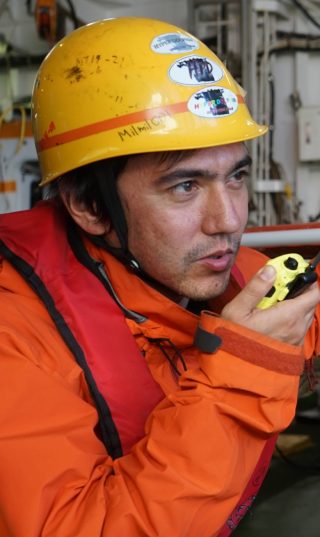A few days ago we invited anyone who was interested to ask Principal Investigator Dr Blair Thornton (University of Southampton) and the international engineering team on Schmidt Ocean Institute’s research vessel Falkor questions about underwater robotics and our current expedition.
The experts onboard are conducting research on dynamically changing environments like cold seeps with four different robots, each one with different capabilities. Yet the underwater robots used will not be just mindless gatherers of data, they will make important decisions based on an increased awareness of their surroundings.
Here are many of the questions we received. Enjoy!
What are some specific applications that underwater drones can be deployed in?
Mapping the seafloor is a big application area. People are also looking into intervention and manipulation missions but for now, observation is the area autonomous underwater vehicles, or underwater drones) are having the biggest impact.




Would you say the underwater robotics field is a difficult one to become a part of? Opportunistic instead of consistent?
Yes. The main reason is that even the sensors we use to do simple things like localize (know where we are) and communicate underwater are very expensive, as is the infrastructure we need to support their operations (i.e. a ship). Making the field more accessible to the broader robotics community is a huge priority for us and a key point to advance our field.
Because ships are so expensive, many groups are looking at ways to efficiently operate larger numbers of robots at the same time. This is to make better use of the same ship time, but the ultimately goal is to have robots switching in and out of operations while collectively making continuous observations of the ocean. There are also researchers looking at how robots can make better use of, and interact with, existing infrastructures such as seafloor cables networks and pipelines.
What are the latest trends in global autonomous underwater robotics market?
Increased autonomy and building systems with multiple robotic agents.
What method of movement is efficient for an underwater robot, using propeller or using fish-like movements?
For the most part, a propeller. While biological tissue and motion is based on linear contraction of muscles, mechatronic systems are ultimately based on objects that spin around in circles. We can copy how animals move very well, but it is often less efficient because the fundamental way in which the actuation is achieved is not the same. However, there are some researchers looking at different ways of achieving the actuation, so who knows how things will change in the future.
The main type is oil/gas. There are also gas/methane hydrates, mud volcanoes and brine seeps.
Hydrothermal vents emit fluids that are heated by geothermal activity. Cold seeps are typically created by trapped hydrocarbons that seep out of fissures.
Cold seeps are typically created by trapped hydrocarbons that seep out of fissures. There are different types of seeps oil/gas, gas/methane hydrates, mud volcanoes and brine seeps.
Most underwater robots are now unmanned. These can be broadly split into 3 categories. Remotely operated systems, that are teleoperated through a cable connecting the robot to a ship, autonomous robots that do not require a tether and actively propel themselves through the environment, and more passive robotic systems, that simply like to drift along on currents and can stay out in the ocean for several months/years.
What is the overall goal at Schmidt Ocean Institute? How far are you from meeting this goal?
Our goal is to combine advanced science with state-of-the-art technology to achieve lasting results in ocean research, to catalyze sharing of the information, and to communicate this knowledge to audiences around the world. We foster a deeper understanding of our environment. We try to achieve this on every mission that we select.
They can gather information about the ocean that cannot be gathered in any other way, and do so without putting humans in risky situations.
Why is underwater robotics becoming increasingly popular now?
What kinds of cruises does Schmidt Ocean Institute have coming up later this year?
What types of data do you collect and what methodology have you chosen to collect it?
What kind of research is Schmidt Ocean Institute focused on?
We inform the development of our research program through continuous dialogue with the global oceanographic research and technology development communities. Please refer to the following links for reports on the findings and recommendations stemming from our 2017 Planning Workshop, 2015 Planning Workshop, 2014 Planning Workshop, and 2013 Research Symposium.
You can learn more on our strategic interests page: schmidtocean.org/about/strategic-focus-areas/
What other organizations are Schmidt Ocean Institute currently working with?
Schmidt Ocean Institute works with many different science institutions internationally on each expedition. To get a specific list you can view our collaborators page: schmidtocean.org/about/collaborators/
What will your underwater robots be able to accomplish that previous underwater robotics ventures have not?
We are mapping extremely wide areas using underwater camera systems. This in itself is quite unique, but what makes this expedition very unique is that the imagery collected by one robot will be used to direct other robots to the most interesting places. Like a tour guide.
I believe one of the reasons the public connects with space more than underwater is visuals. Images from space are much more colorful and wonderous. What advancements in underwater site and imagery are being developed? What advancements would you like to see?
Well the colors seen in most of the space imagery are artist impressions, and these artists are really talented people. For underwater imagery, the area you can see in a single image is limited by how quickly light is absorbed by water, so researchers are working on ways to make big maps by stitching together many thousands of these images. I would like to see these images being turned into human insight. There is a saying that a picture speaks a thousand words, but our challenge is to turn many thousands of images into human understanding of the ocea
What are the steps someone should take to become a marine technician?
Currently there’s no set path to become Marine Technician. Veit, one of the MTs onboard first studied Geology, then he joined a ship and began gathering useful knowledge until he became a Marine Technician. Paul, the Lead MT, first started with an electronics degree and then joined a ship. Kaarel, another MT, started as a deckhand while he was studying neurosciences. They advise to get a degree in sciences or IT and find apprenticeships as a ship engineer or marine technician. If the person is in the US, they can also look into a MATE (Marine Advance Tech Education) Internship. We also have more information about careers ore on our Careers At Sea webpage.
Humans deep sea dive to gather data, but the design of underwater robots can change that. What does the future look like for underwater research?
Unmanned robots can work for much longer periods of time and expose themselves to higher levels of risk then manned submersibles. I think that most organisations will focus on advancing unmanned robots to the point that humans no longer “need” to put themselves in risky situations for research.
How can using underwater robotics help us learn more about climate change?